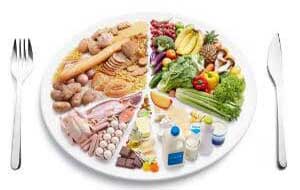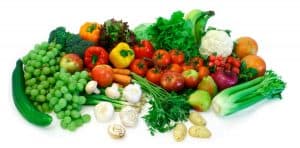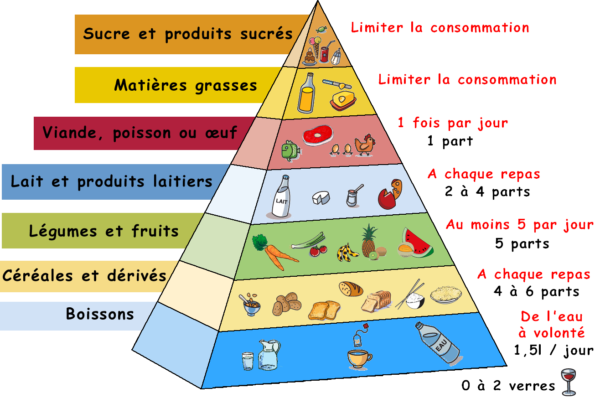A reliable source on many subjects.

A reliable source on many subjects.

![]()

Rebalancing your diet is one of the keys to keeping your figure, but also to staying in shape and enjoying life to the full! It’s a fact that the era in which we live today tends to promote the hamburger rather than the plate of crudités!
Why are we so sick of what we eat?
Faced with this global phenomenon, what is a balanced diet, and how can we achieve it on a daily basis, through simple but effective gestures?
Follow the guide to successfully rebalance your diet and get back into shape!
Thousands of years ago, mankind lived a hunter/gatherer lifestyle, and was predominantly omnivorous. This nomadic lifestyle, with its combination of physical hardship and precarious living conditions, ensured that our ancestors maintained a balance between energy expenditure and caloric intake.
The evolution of humanity and the sedentarization of the majority of populations have, however, brought about major changes in diet. With the advent of livestock farming, and then of crops, the variety of foods changed (contrary to popular belief, only a few species of animal could be bred, and plants, then essentially wild, were also difficult to cultivate). The result was a gradual decline in the quality of our food, in favor of quantity.
Of course, the industrial revolution greatly amplified this phenomenon, and industrialization has had a considerable impact on the food industry. We produce more, faster; we store longer and in greater quantities; we work harder…and we end up consuming products that are further and further removed from their natural simplicity, often out of season or “ready-to-eat”.
This rapid expansion of unstructured eating habits, coupled with the emergence of fast food, has led to an alarming rise in obesity, diabetes and cardiovascular disease over the last few decades. These are three of the greatest metabolic scourges facing humanity.
Faced with this veritable pandemic, how can we manage to get back on track with a healthy, balanced diet, and thus preserve our health – and, of course, our figure? How can we regain a slim, trim figure without having to change our lifestyle? And how can we rebalance our diet to remedy the imbalance we experience every day?
Before we talk about rebalancing our diet, let’s start by understanding what a balanced diet is first.

A balanced diet means balancing the body’s needs and nutrient intake, as well as the different types of food required throughout the day. A harmonious distribution of meals helps to anticipate needs, and the consumption of varied foods, in appropriate quantities, completes the balance.
Certain parameters, such as stress levels or lack of physical activity, play an important role in your feeling of balance and fitness, in your daily energy levels, but also (and of course) in your figure!
But leaving those considerations aside, let’s take a closer look at how, with a few simple gestures, you can rebalance your diet, lose weight and feel great!
A balanced diet means providing your body with the nutrients it needs, according to your age and lifestyle. Indeed, if you already engage in regular physical activity, or if you work in physically demanding conditions, your energy requirements are not the same as if you lead a largely sedentary lifestyle.
A few key principles, easy to implement, will enable you to begin your dietary rebalancing in complete serenity, without frustration or anxiety. Let’s get started!
This pyramid is extremely useful for those who want a balanced diet. It groups the different food families according to their dominant nutrients.
Foods at the base of the pyramid should be eaten in large quantities, and should form the basis of your diet. Foods at the top should be eaten in moderation, as they are rich in sugar and fat, and therefore contribute to weight gain.

Water helps to hydrate, eliminate toxins and re-mineralize the body. Drink 1.5 liters a day to stay on top form, and don’t replace it with sodas or other sugary drinks, which don’t have the same virtues!
Starchy foods give you fuel and a feeling of satiety. They help you avoid cravings and untimely snacking, and are therefore a precious aid when you want to lose weight.
It is therefore essential to eat a calcium-rich product at every meal, whether in the form of dairy products (yoghurt, fromage frais, cheese) or, if you have trouble digesting cow’s milk, in oilseeds and green vegetables.
The important thing is to vary the sources, using oil (olive, rapeseed, grape seed…), margarine or butter…

Your body needs the right fuel to function optimally throughout the day, depending on your activities. Ideally, you should eat 3 to 4 meals a day, dividing your food intake as follows:

As you’ve probably noticed, these needs vary, and it’s important to listen to your body in order to achieve an optimal dietary balance. Respect your body’s signals of hunger and satiety; adapt the organization of your meals to suit your lifestyle and schedule; eat according to your tastes.
A balanced diet rich in simple, unprocessed, tasty foods will help you get back into shape, shed those embarrassing kilos and brim with vitality!